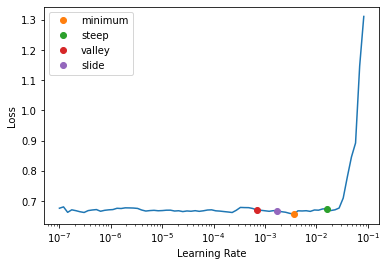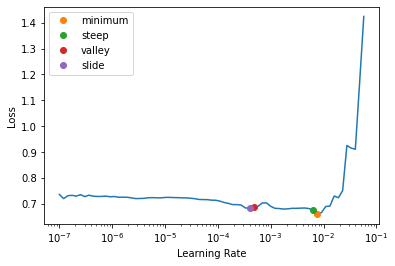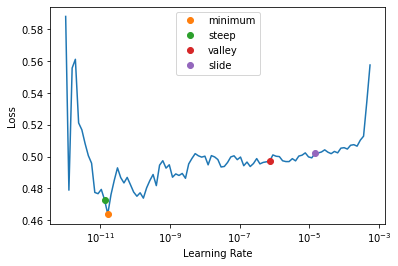Using GPU #1: GeForce GTX 1080 TiUsing the Low-level fastai API
GLUE tasks
| Abbr | Name | Task type | Description | Size | Metrics |
|---|---|---|---|---|---|
| CoLA | Corpus of Linguistic Acceptability | Single-Sentence Task | Predict whether a sequence is a grammatical English sentence | 8.5k | Matthews corr. |
| SST-2 | Stanford Sentiment Treebank | Single-Sentence Task | Predict the sentiment of a given sentence | 67k | Accuracy |
| MRPC | Microsoft Research Paraphrase Corpus | Similarity and Paraphrase Tasks | Predict whether two sentences are semantically equivalent | 3.7k | F1/Accuracy |
| SST-B | Semantic Textual Similarity Benchmark | Similarity and Paraphrase Tasks | Predict the similarity score for two sentences on a scale from 1 to 5 | 7k | Pearson/Spearman corr. |
| QQP | Quora question pair | Similarity and Paraphrase Tasks | Predict if two questions are a paraphrase of one another | 364k | F1/Accuracy |
| MNLI | Mulit-Genre Natural Language Inference | Inference Tasks | Predict whether the premise entails, contradicts or is neutral to the hypothesis | 393k | Accuracy |
| QNLI | Stanford Question Answering Dataset | Inference Tasks | Predict whether the context sentence contains the answer to the question | 105k | Accuracy |
| RTE | Recognize Textual Entailment | Inference Tasks | Predict whether one sentece entails another | 2.5k | Accuracy |
| WNLI | Winograd Schema Challenge | Inference Tasks | Predict if the sentence with the pronoun substituted is entailed by the original sentence | 634 | Accuracy |
Define the task and hyperparmeters
We’ll use the “distilroberta-base” checkpoint for this example, but if you want to try an architecture that returns token_type_ids for example, you can use something like bert-cased.
task = 'mrpc'
task_meta = glue_tasks[task]
train_ds_name = task_meta['dataset_names']["train"]
valid_ds_name = task_meta['dataset_names']["valid"]
test_ds_name = task_meta['dataset_names']["test"]
task_inputs = task_meta['inputs']
task_target = task_meta['target']
task_metrics = task_meta['metric_funcs']
pretrained_model_name = "distilroberta-base" # bert-base-cased | distilroberta-base
bsz = 16
val_bsz = bsz *2Raw data
Let’s start by building our DataBlock. We’ll load the MRPC datset from huggingface’s datasets library which will be cached after downloading via the load_dataset method. For more information on the datasets API, see the documentation here.
raw_datasets = load_dataset('glue', task)
print(f'{raw_datasets}\n')
print(f'{raw_datasets[train_ds_name][0]}\n')
print(f'{raw_datasets[train_ds_name].features}\n')Reusing dataset glue (/home/wgilliam/.cache/huggingface/datasets/glue/mrpc/1.0.0/dacbe3125aa31d7f70367a07a8a9e72a5a0bfeb5fc42e75c9db75b96da6053ad)DatasetDict({
train: Dataset({
features: ['idx', 'label', 'sentence1', 'sentence2'],
num_rows: 3668
})
validation: Dataset({
features: ['idx', 'label', 'sentence1', 'sentence2'],
num_rows: 408
})
test: Dataset({
features: ['idx', 'label', 'sentence1', 'sentence2'],
num_rows: 1725
})
})
{'idx': 0, 'label': 1, 'sentence1': 'Amrozi accused his brother , whom he called " the witness " , of deliberately distorting his evidence .', 'sentence2': 'Referring to him as only " the witness " , Amrozi accused his brother of deliberately distorting his evidence .'}
{'idx': Value(dtype='int32', id=None), 'label': ClassLabel(num_classes=2, names=['not_equivalent', 'equivalent'], names_file=None, id=None), 'sentence1': Value(dtype='string', id=None), 'sentence2': Value(dtype='string', id=None)}
Prepare the Hugging Face objects
My #1 answer as to the question, “Why aren’t my transformers training?”, is that you likely don’t have num_labels set correctly. The default for sequence classification tasks is 2, and even though that is what we have here, let’s show how to set this either way.
n_lbls = raw_datasets[train_ds_name].features[task_target].num_classes
n_lbls2model_cls = AutoModelForSequenceClassification
hf_arch, hf_config, hf_tokenizer, hf_model = get_hf_objects(pretrained_model_name,
model_cls=model_cls,
config_kwargs={'num_labels': n_lbls})
print(hf_arch)
print(type(hf_config))
print(type(hf_tokenizer))
print(type(hf_model))roberta
<class 'transformers.models.roberta.configuration_roberta.RobertaConfig'>
<class 'transformers.models.roberta.tokenization_roberta_fast.RobertaTokenizerFast'>
<class 'transformers.models.roberta.modeling_roberta.RobertaForSequenceClassification'>Build the tokenized datasets
Tokenize (and numericalize) the raw text using the datasets.map function, and then remove unnecessary and/or problematic attributes from the resulting tokenized dataset (e.g., things like strings that can’t be converted to a tensor)
def tokenize_function(example):
return hf_tokenizer(*[example[inp] for inp in task_inputs ], truncation=True)
tokenized_datasets = raw_datasets.map(tokenize_function, batched=True)tokenized_datasets = tokenized_datasets.remove_columns(task_inputs + ['idx'])
tokenized_datasets = tokenized_datasets.rename_column('label', 'labels')
tokenized_datasets["train"].column_names['attention_mask', 'input_ids', 'labels']1. Using PyTorch DataLoaders
Build the DataLoaders
BlurrBatchCreator augments the default DataCollatorWithPadding method to return a tuple of inputs/targets. As huggingface returns a BatchEncoding object after the call to DataCollatorWithPadding, this class will convert it to a dict so that fastai can put the batches on the correct device for training
Build the plain ol’ PyTorch DataLoaders
data_collator = TextBatchCreator(hf_arch, hf_config, hf_tokenizer, hf_model)
train_dataloader = torch.utils.data.DataLoader(tokenized_datasets[train_ds_name], shuffle=True, batch_size=bsz,
collate_fn=data_collator)
eval_dataloader = torch.utils.data.DataLoader(tokenized_datasets[valid_ds_name], batch_size=val_bsz,
collate_fn=data_collator)dls = DataLoaders(train_dataloader, eval_dataloader)for b in dls.train: break
b[0]['input_ids'].shape, b[1].shape, b[0]['input_ids'].device, b[1].device(torch.Size([16, 72]),
torch.Size([16]),
device(type='cpu'),
device(type='cpu'))Train
With our plain ol’ PyTorch DataLoaders built, we can now build our Learner and train.
Note: Certain fastai methods like dls.one_batch, get_preds and dls.test_dl won’t work with standard PyTorch DataLoaders … but we’ll show how to remedy that in a moment :)
model = BaseModelWrapper(hf_model)
learn = Learner(dls,
model,
opt_func=partial(Adam),
loss_func=PreCalculatedCrossEntropyLoss(),
metrics=task_metrics,
cbs=[BaseModelCallback],
splitter=blurr_splitter).to_fp16()
learn.freeze()learn.summary()learn.lr_find(suggest_funcs=[minimum, steep, valley, slide])SuggestedLRs(minimum=0.00036307806149125097, steep=0.015848932787775993, valley=0.0006918309954926372, slide=0.001737800776027143)
learn.fit_one_cycle(1, lr_max=2e-3)| epoch | train_loss | valid_loss | f1_score | accuracy | time |
|---|---|---|---|---|---|
| 0 | 0.532319 | 0.480080 | 0.843450 | 0.759804 | 00:10 |
learn.unfreeze()
learn.lr_find(start_lr=1e-12, end_lr=2e-3, suggest_funcs=[minimum, steep, valley, slide])SuggestedLRs(minimum=1.3779609397968073e-11, steep=8.513399187004556e-12, valley=4.234914013068192e-05, slide=2.2274794901022688e-05)
learn.fit_one_cycle(2, lr_max=slice(2e-5, 2e-4))| epoch | train_loss | valid_loss | f1_score | accuracy | time |
|---|---|---|---|---|---|
| 0 | 0.467265 | 0.358624 | 0.889643 | 0.840686 | 00:19 |
| 1 | 0.279453 | 0.335163 | 0.910321 | 0.870098 | 00:19 |
Evaluate
How did we do?
val_res = learn.validate()val_res_d = { 'loss': val_res[0]}
for idx, m in enumerate(learn.metrics): val_res_d[m.name] = val_res[idx+1]
val_res_d{'loss': 0.33516255021095276,
'f1_score': 0.9103214890016922,
'accuracy': 0.8700980544090271}# preds, targs = learn.get_preds() # ... won't work :(Inference
Let’s do item inference on an example from our test dataset
raw_test_df = raw_datasets[test_ds_name].to_pandas()
raw_test_df.head()| idx | label | sentence1 | sentence2 | |
|---|---|---|---|---|
| 0 | 0 | 1 | PCCW 's chief operating officer , Mike Butcher , and Alex Arena , the chief financial officer , will report directly to Mr So . | Current Chief Operating Officer Mike Butcher and Group Chief Financial Officer Alex Arena will report to So . |
| 1 | 1 | 1 | The world 's two largest automakers said their U.S. sales declined more than predicted last month as a late summer sales frenzy caused more of an industry backlash than expected . | Domestic sales at both GM and No. 2 Ford Motor Co. declined more than predicted as a late summer sales frenzy prompted a larger-than-expected industry backlash . |
| 2 | 2 | 1 | According to the federal Centers for Disease Control and Prevention ( news - web sites ) , there were 19 reported cases of measles in the United States in 2002 . | The Centers for Disease Control and Prevention said there were 19 reported cases of measles in the United States in 2002 . |
| 3 | 3 | 0 | A tropical storm rapidly developed in the Gulf of Mexico Sunday and was expected to hit somewhere along the Texas or Louisiana coasts by Monday night . | A tropical storm rapidly developed in the Gulf of Mexico on Sunday and could have hurricane-force winds when it hits land somewhere along the Louisiana coast Monday night . |
| 4 | 4 | 0 | The company didn 't detail the costs of the replacement and repairs . | But company officials expect the costs of the replacement work to run into the millions of dollars . |
test_ex_idx = 0
test_ex = raw_test_df.iloc[test_ex_idx][task_inputs].values.tolist()inputs = hf_tokenizer(*test_ex, return_tensors="pt").to('cuda:1')outputs = hf_model(**inputs)
outputs.logitstensor([[-1.6640, 1.0325]], device='cuda:1', grad_fn=<AddmmBackward0>)torch.argmax(torch.softmax(outputs.logits, dim=-1))tensor(1, device='cuda:1')Let’s do batch inference on the entire test dataset
# test_dl = dls.test_dl(tokenized_datasets[test_ds_name]) # ... won't work :(
test_dataloader = torch.utils.data.DataLoader(tokenized_datasets[test_ds_name],
shuffle=False, batch_size=val_bsz,
collate_fn=data_collator)
hf_model.eval()
probs, preds = [], []
for xb,yb in test_dataloader:
xb = to_device(xb,'cuda')
with torch.no_grad():
outputs = hf_model(**xb)
logits = outputs.logits
predictions = torch.argmax(logits, dim=-1)
probs.append(logits)
preds.append(predictions)all_probs = torch.cat(probs, dim=0)
all_preds = torch.cat(preds, dim=0)
print(all_probs.shape, all_preds.shape)torch.Size([1725, 2]) torch.Size([1725])2. Using fastai DataLoaders
Let’s start with a fresh set of huggingface objects
hf_arch, hf_config, hf_tokenizer, hf_model = get_hf_objects(pretrained_model_name,
model_cls=model_cls,
config_kwargs={'num_labels': n_lbls})… and the fix is this simple! Instead of using the PyTorch Dataloaders, let’s use the fastai flavor like this …
train_dataloader = TextDataLoader(tokenized_datasets[train_ds_name],
hf_arch, hf_config, hf_tokenizer, hf_model,
preproccesing_func=preproc_hf_dataset, shuffle=True, batch_size=bsz)
eval_dataloader = TextDataLoader(tokenized_datasets[valid_ds_name],
hf_arch, hf_config, hf_tokenizer, hf_model,
preproccesing_func=preproc_hf_dataset, batch_size=val_bsz)
dls = DataLoaders(train_dataloader, eval_dataloader)Everything else is the same … but now we get both our fast.ai AND Blurr features back!
dls.show_batch(dataloaders=dls, trunc_at=500, max_n=2)| text | target | |
|---|---|---|
| 0 | The broader Standard & Poor's 500 Index <.SPX > edged down 9 points, or 0.98 percent, to 921. The Standard & Poor's 500 Index shed 5.20, or 0.6 percent, to 924.42 as of 9 : 33 a.m. in New York. | 1 |
| 1 | " When I talked to him last time, did I think that was the end-all - one conversation with somebody? When I talked to him last time, did I think it was the end-all? | 1 |
b = dls.one_batch()
b[0]['input_ids'].shape, b[1].shape, b[0]['input_ids'].device, b[1].device(torch.Size([16, 81]),
torch.Size([16]),
device(type='cpu'),
device(type='cpu'))Train
model = BaseModelWrapper(hf_model)
learn = Learner(dls,
model,
opt_func=partial(Adam),
loss_func=PreCalculatedCrossEntropyLoss(),
metrics=task_metrics,
cbs=[BaseModelCallback],
splitter=blurr_splitter).to_fp16()
learn.freeze()learn.lr_find(suggest_funcs=[minimum, steep, valley, slide])SuggestedLRs(minimum=0.0007585775572806596, steep=0.0063095735386013985, valley=0.0004786300996784121, slide=0.0003981071640737355)
learn.fit_one_cycle(1, lr_max=2e-3)| epoch | train_loss | valid_loss | f1_score | accuracy | time |
|---|---|---|---|---|---|
| 0 | 0.531747 | 0.474415 | 0.855738 | 0.784314 | 00:12 |
learn.unfreeze()
learn.lr_find(start_lr=1e-12, end_lr=2e-3, suggest_funcs=[minimum, steep, valley, slide])SuggestedLRs(minimum=1.6185790555067748e-12, steep=1.3065426344993636e-11, valley=7.238505190798605e-07, slide=1.451419939257903e-05)
learn.fit_one_cycle(2, lr_max=slice(2e-5, 2e-4))| epoch | train_loss | valid_loss | f1_score | accuracy | time |
|---|---|---|---|---|---|
| 0 | 0.461239 | 0.342700 | 0.887299 | 0.845588 | 00:20 |
| 1 | 0.274237 | 0.305770 | 0.897527 | 0.857843 | 00:20 |
learn.show_results(learner=learn, trunc_at=500, max_n=2)| text | target | prediction | |
|---|---|---|---|
| 0 | The state's House delegation currently consists of 17 Democrats and 15 Republicans. Democrats hold a 17-15 edge in the state's U.S. House delegation. | 1 | 0 |
| 1 | The announcement was made during the recording of a Christmas concert attended by top Vatican cardinals, bishops, and many elite from Italian society, witnesses said. The broadside came during the recording on Saturday night of a Christmas concert attended by top Vatican cardinals, bishops and many elite of Italian society, witnesses said. | 1 | 1 |
Evaluate
How did we do?
val_res = learn.validate()val_res_d = { 'loss': val_res[0]}
for idx, m in enumerate(learn.metrics): val_res_d[m.name] = val_res[idx+1]
val_res_d{'loss': 0.30576950311660767,
'f1_score': 0.8975265017667844,
'accuracy': 0.8578431606292725}Now we can use Learner.get_preds()
preds, targs = learn.get_preds()
print(preds.shape, targs.shape)
print(accuracy(preds, targs))torch.Size([408, 2]) torch.Size([408])
TensorBase(0.8578)Inference
Let’s do item inference on an example from our test dataset
raw_test_df = raw_datasets[test_ds_name].to_pandas()
raw_test_df.head()| idx | label | sentence1 | sentence2 | |
|---|---|---|---|---|
| 0 | 0 | 1 | PCCW 's chief operating officer , Mike Butcher , and Alex Arena , the chief financial officer , will report directly to Mr So . | Current Chief Operating Officer Mike Butcher and Group Chief Financial Officer Alex Arena will report to So . |
| 1 | 1 | 1 | The world 's two largest automakers said their U.S. sales declined more than predicted last month as a late summer sales frenzy caused more of an industry backlash than expected . | Domestic sales at both GM and No. 2 Ford Motor Co. declined more than predicted as a late summer sales frenzy prompted a larger-than-expected industry backlash . |
| 2 | 2 | 1 | According to the federal Centers for Disease Control and Prevention ( news - web sites ) , there were 19 reported cases of measles in the United States in 2002 . | The Centers for Disease Control and Prevention said there were 19 reported cases of measles in the United States in 2002 . |
| 3 | 3 | 0 | A tropical storm rapidly developed in the Gulf of Mexico Sunday and was expected to hit somewhere along the Texas or Louisiana coasts by Monday night . | A tropical storm rapidly developed in the Gulf of Mexico on Sunday and could have hurricane-force winds when it hits land somewhere along the Louisiana coast Monday night . |
| 4 | 4 | 0 | The company didn 't detail the costs of the replacement and repairs . | But company officials expect the costs of the replacement work to run into the millions of dollars . |
test_ex_idx = 0
test_ex = raw_test_df.iloc[test_ex_idx][task_inputs].values.tolist()inputs = hf_tokenizer(*test_ex, return_tensors="pt").to('cuda:1')outputs = hf_model(**inputs)
outputs.logitstensor([[-1.8848, 2.3550]], device='cuda:1', grad_fn=<AddmmBackward0>)torch.argmax(torch.softmax(outputs.logits, dim=-1))tensor(1, device='cuda:1')Let’s do batch inference on the entire test dataset using dls.test_dl
test_dl = dls.test_dl(tokenized_datasets[test_ds_name])
preds = learn.get_preds(dl=test_dl)
preds(tensor([[0.0142, 0.9858],
[0.0965, 0.9035],
[0.0098, 0.9902],
...,
[0.0504, 0.9496],
[0.0096, 0.9904],
[0.0355, 0.9645]]),
tensor([1, 1, 1, ..., 0, 1, 1]))Summary
So you can see, with one simple swap of the DataLoader objects, you can get back a lot of that nice fastai functionality folks using the mid/high-level APIs have at their disposal. Nevertheless, if you’re hell bent on using the standard PyTorch DataLoaders, you’re still good to go with using the fastai Learner, it’s callbacks, etc…